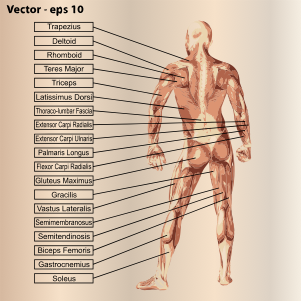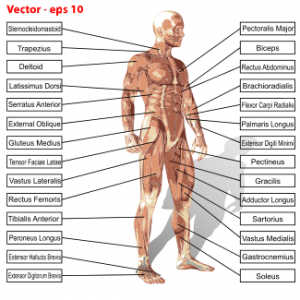No products in the basket.
Muscular System
MUSCULAR SYSTEM
Structure and Function
The muscular system refers to all muscles of the body, including those attached to bones and those along the walls of internal structures, such as the heart. On the basis of location, microscopic structure, and neural control, muscles are classified as follows:
- Skeletal (striated voluntary) muscles: Attached to bones
- Visceral or smooth (nonstriated, involuntary) muscles: Lining the walls of internal structures, such as veins and arteries
- Cardiac (striated involuntary) muscles: Make up the wall of the heart
Muscles provide movement, maintain posture, and produce heat. Movement takes place not only during locomotion but also during body movements, changes in the size of openings, and propulsion
of substances (e.g., propulsion of blood through veins or passage of food through intestines). Posture is maintained during sitting and standing by continued partial contraction of specific muscles. Muscle cells that provide mechanical energy for movement also release energy in the form of heat. All three muscle types work by extending, contracting, and conducting and by being easily stimulated.
Skeletal muscles (more than 400 in humans) compose approximately 40 percent of a man’s body. In contrast, women have less muscle and more fat than men. Muscles are strongest at about age 25, but with proper nutrition and exercise, they can remain strong throughout life. Without sufficient exercise, muscles become smaller and weaker. Glycogen is the form of stored glucose in muscles. Without stores of glycogen, muscles
must wait for glucose, which is transported through the bloodstream. Exercise increases the amount of glycogen available for muscles, which in turn allows them to function more easily.
Disorders of the Muscular System
- Muscular dystrophy (MD) (gradual wasting and weakening of the skeletal muscles)
- Conditions that disrupt nerve stimulation (as in severe accidents and myasthenia gravis, which is muscular fatigue due to overuse)
- Muscle cramps and tendonitis (inflammation of the tendons)
- Muscle atrophy (muscles waste away from lack of use)
- Multiple sclerosis (MS) and amyotropic lateral sclerosis (ALS) (MS and ALS are nervous system diseases that involve destruction of the nerves. This results in impaired nerve impulses that can cause weak, numb, or atrophied muscles.)
- Viral infections, such as poliomyelitis (Poliomyelitis is a preventable nervous system disease that can cause atrophy and deformities of muscles in late stages. Vaccinations prevent the disease.)




